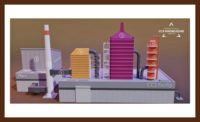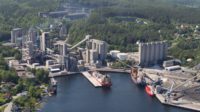

Cement production contributes an estimated 6% of global greenhouse-gas emissions, say scientists who are trying to chip away at the pollution problem. Two start-ups, one in Canada and another in Arizona, are among the newer entries in the effort to produce cleaner cement and concrete.

|
| WAGNER |
Similar to how chemical admixtures are piped in today, equipment retrofitted onto a concrete mixer injects CO2 into the concrete. "When CO2 is added to the concrete during mixing, the CO2 reacts with water to form carbonate ions," the company's website says. "The carbonate then quickly reacts with calcium ions released from the cement to rapidly form a limestone-like material. This mineral is created in the form of nanomaterials dispersed throughout the concrete mix."
The conversion of CO2 gas to solid carbonate permanently sequesters the gas in the concrete. The company has worked in the masonry field for several years but just began using the technology for ready-mix. "We expect to have several fully operational ready-mix-concrete installations by the end of the year," Wagner says.
CarbonCure sequesters different amounts of CO2, depending on the individual producer's mix design, Wagner adds. "Typically, the amount of CO2 that is sequestered is around 1% of the weight of cement," she explains. "In ready-mix-concrete applications, the addition of CO2 can also unlock material performance enhancements, which can lead to mix-design optimizations and further CO2 reductions."

|
| STONE |
Stone stumbled on this discovery in 2002, while pursuing a doctorate at the University of Arizona. "It has taken years to get just a basic understanding of the chemistry involved," he says. Waste steel dust makes up 60% of the material's dry ingredients; fly ash is 20%, and ground limestone is another 10% of the mix. Exposing the dry ingredients to water and CO2 at ambient temperature "drives the oxidation reaction that forms the cementing iron-carbonate mineral matrix," Stone says, adding that hydrogen gas "is a by-product that might be harvested at large-scale operations."
The resulting paste has impressive qualities, reaching 5,500 to 6,500 psi, "though we have reached 10,000," Stone says. After four days of curing in water and CO2 exposure, Ferrock can reach strength comparable with portland cement after a 28-day moist cure; full strength is achieved in 10 days. Flexural strength tests have shown Ferrock to be up to seven times stronger than portland when both test specimens have 1% glass fibers. With these qualities as the potential prize, Stone and Narayanan Neithalath, associate professor and civil engineer at Arizona State University, are conducting research to improve the product.
The main weakness of Ferrock is "the slowness of the reaction due to the diffusion of CO2 into the interstitial water in the thick paste and the subsequent formation of iron carbonate," Stone concedes. Using a method that has been effective at carbonating slabs, walls and other thick structures, the gas is injected into the fresh paste via embedded thin-walled steel conduit perforated every four inches with ¼-in.-dia holes. Crushed-stone aggregate is needed to make the poured material porous and allow the CO2 to permeate it, but "some strength is sacrificed with this method," Stone says. "We are working on ways of introducing all of the CO2 initially, along with the water, to make the subsequent gassing unnecessary."
Storage, preparation, delivery and placement of Ferrock are conventional but with different materials. In the dry state, Ferrock is just like portland cement, Stone says, noting, "After mixing with water, it will not harden until exposed to CO2 or allowed to dry out, which allows some oxidation in air." The usual additives will work with Ferrock, and "we are looking at the special synergy of Ferrock with glass, steel, carbon fibers and other fibrous reinforcement," he adds. Unless porosity is desired, glass may be crushed into various sizes of aggregate and used in place of sand and gravel in the mix. A slump test is not needed. "In the iron carbonates we are working with, water is only an agent of mass transfer," not an agent in the reaction, Neithalath says. "You need water to disperse the particles uniformly and carry the carbon dioxide inside the material to form those binding agents."
Despite its promise, Ferrock faces a major hurdle in gaining industry acceptance. To overcome market inertia, the challenge of meeting engineering properties and the resistance of standard-setting organizations and users reluctant to bet their million-dollar project on an unproven material, "it takes a long time for the industry to accept change," says Steve Kosmatka, vice president of research and technical services for the Portland Cement Association. Portland cement was invented in England in 1824 but was not widely used in the U.S. until the 1860s, he notes. Its advantages over natural cement were so great that it became the standard, but it still took decades. Supply of key materials is a further challenge, Kosmatka and Stone concur. Waste steel dust from large steel shot blasting has met the needs for research, but, "on a large scale, we might tap the direct reduced iron supply, which is huge, but it's a feedstock for steel production and not a waste, so it's much more expensive," Stone says.
The Canadian company CarbonCure Technologies Inc., Dartmouth, Nova Scotia, provides a technology to masonry and ready-mix-concrete producers that sequesters waste carbon dioxide (CO) into concrete, says Jennifer Wagner, vice president of sustainability. "The process works with any type of conventional cement," she notes. As with CarbonCure, most "green" concretes start with conventional portland cement. Ferrock, which uses steel dust as its basic component, takes a different approach. While portland-cement production requires substantial energy—much of it from fossil fuels emitting CO—Ferrock requires no energy input. "The embodied energy in the reduced iron drives the oxidation reaction," says David Stone, the inventor and founder of Iron Shell LLC, the Tucson-based company that is working to commercialize the technology.



Post a comment to this article
Report Abusive Comment